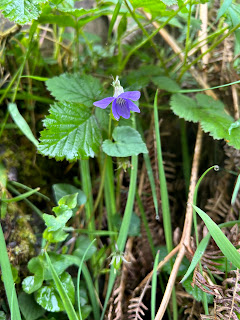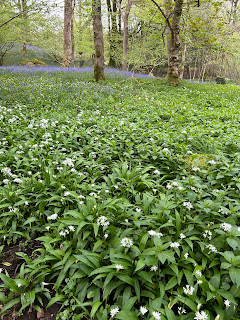Bluebells Thriving at Bel's Wood
'Bluebells are one of the main biological indicators that scientists use to judge whether a spot is an ancient woodland. An ancient woodland is an area of woods that has been recorded on a map since the year 1600 CE. That’s approximately when maps started being more accurate, so we know that these areas have been filled with trees for approximately 400 years. They are relatively undisturbed by human development and, as a result, foster unique and complex communities of natural life.' (Hants local government website).
I have a map including Bel's Wood dated 1895 (Ordnance Survey Map) and no woodland is showing. There are older maps online which also show that the land and it is always cleared of woodland. Wood would have been used at Starnthwaite Mill nearby and there is evidence of coppicing of hazel trees in some areas where there is still patches of trees. The presence of bluebells growing on the land indicates that there was a mature woodland here once.
The land had been heavily grazed by sheep and cattle as well as having very many roe and red deer passing through until Autumn 2020 when a stock fence was erected to separate this land for sale. Also there was dense gorse and bracken limiting the amount of light reaching the ground. The number of bluebells and other wild flowers was very low. In the first spring that I took over the land (April and May 2021) I found a few bluebells near the top gate and along the beck.
I also picked up the following footage which went some way to explaining the lack of them elsewhere!
The deer fence was erected in September 2022 meaning that the following spring the bluebells would be fully protected. This looked like a bumper crop to my eye with more flowers where they were established and new plants appearing in other areas.
It continues to get better. This spring (2024) I can hardly move for bluebells!
I have been placing mulch mats and am trying to work round them but have left some trees unprotected for now as the bluebells are surrounding the saplings. I am thinking let them seed then come back.
I haven't yet achieved that carpet of bluebells giving that amazing blue haze and scent but I can see that in year's to come that can develop. I have done this crude map showing where bluebells came up in 2021 (pink) and where they are in addition in 2024 (yellow).
This is an indication of rewilding now taking place on the land. The cowslips are spreading from one area and there are some new non flowering plants. I try and keep a record of the variety of plants growing and realise that the difficult thing to evidence is density of plants coming up. I am relying on photographs and will continue to record the changes on the land.
Woodland Figwort
Regeneration of trees - birch on the left and sessile oak on the right
Wood sorrel and early purple orchids have come up again but not yet showing signs of spreading
Cowslips are having a good year and are now in two places
The wood violets having been showing since February and the new one of the right here has just come up looking like a taller plant but my app is still saying wood violet but I will investigate.
One day I hope to have a bluebell spread like the ones I have seen in South Cumbria over the last week in established woodlands.






























Wish you joy of your bluebells! xx
ReplyDeleteblimey that was quick 😀 - thanks x
DeleteFantastic progress. I love bluebells 💙 I hope all your wild flowers continue to thrive x
ReplyDeleteJust the hares, rabbits and voles to munch them now so much better 🤞
DeleteBlue Bel's wood!
ReplyDelete🤣🤣
Delete